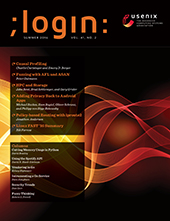USENIX supports diversity, equity, and inclusion and condemns hate and discrimination.
Precious Memory
;login: Enters a New Phase of Its Evolution
For over 20 years, ;login: has been a print magazine with a digital version; in the two decades previous, it was USENIX’s newsletter, UNIX News. Since its inception 45 years ago, it has served as a medium through which the USENIX community learns about useful tools, research, and events from one another. Beginning in 2021, ;login: will no longer be the formally published print magazine as we’ve known it most recently, but rather reimagined as a digital publication with increased opportunities for interactivity among authors and readers.
Since USENIX became an open access publisher of papers in 2008, ;login: has remained our only content behind a membership paywall. In keeping with our commitment to open access, all ;login: content will be open to everyone when we make this change. However, only USENIX members at the sustainer level or higher, as well as student members, will have exclusive access to the interactivity options. Rik Farrow, the current editor of the magazine, will continue to provide leadership for the overall content offered in ;login:, which will be released via our website on a regular basis throughout the year.
As we plan to launch this new format, we are forming an editorial committee of volunteers from throughout the USENIX community to curate content, meaning that this will be a formally peer-reviewed publication. This new model will increase opportunities for the community to contribute to ;login: and engage with its content. In addition to written articles, we are open to other ideas of what you might want to experience.

Most of the Python code that I write isn’t part of an exotic framework or huge application. Instead, it’s usually related to a mundane data analysis task involving a CSV file. It isn’t glamorous, but Python is an effective tool at getting the job done without too much fuss. When working on such problems, I prefer to not worry too much about low-level details (I just want the final answer). However, if you use Python for manipulating a lot of data, you may find that your scripts use a large amount of memory. In this article, I’m going to peek under the covers of how memory gets used in a Python program and explore options for using it more efficiently. I’ll also look at some techniques for exploring and measuring the memory use of your programs. Disclosure: Python 3 is assumed for all of the examples, but the underlying principles apply equally to Python 2.

